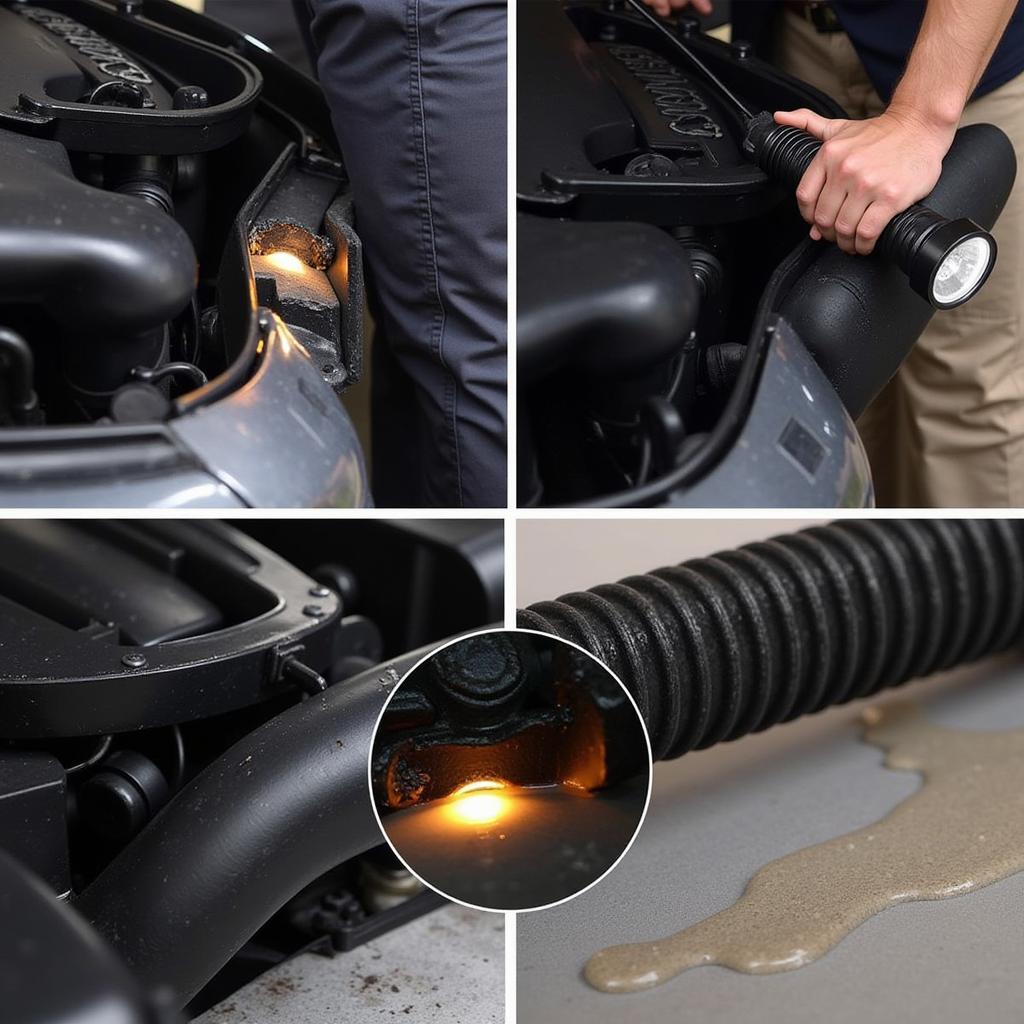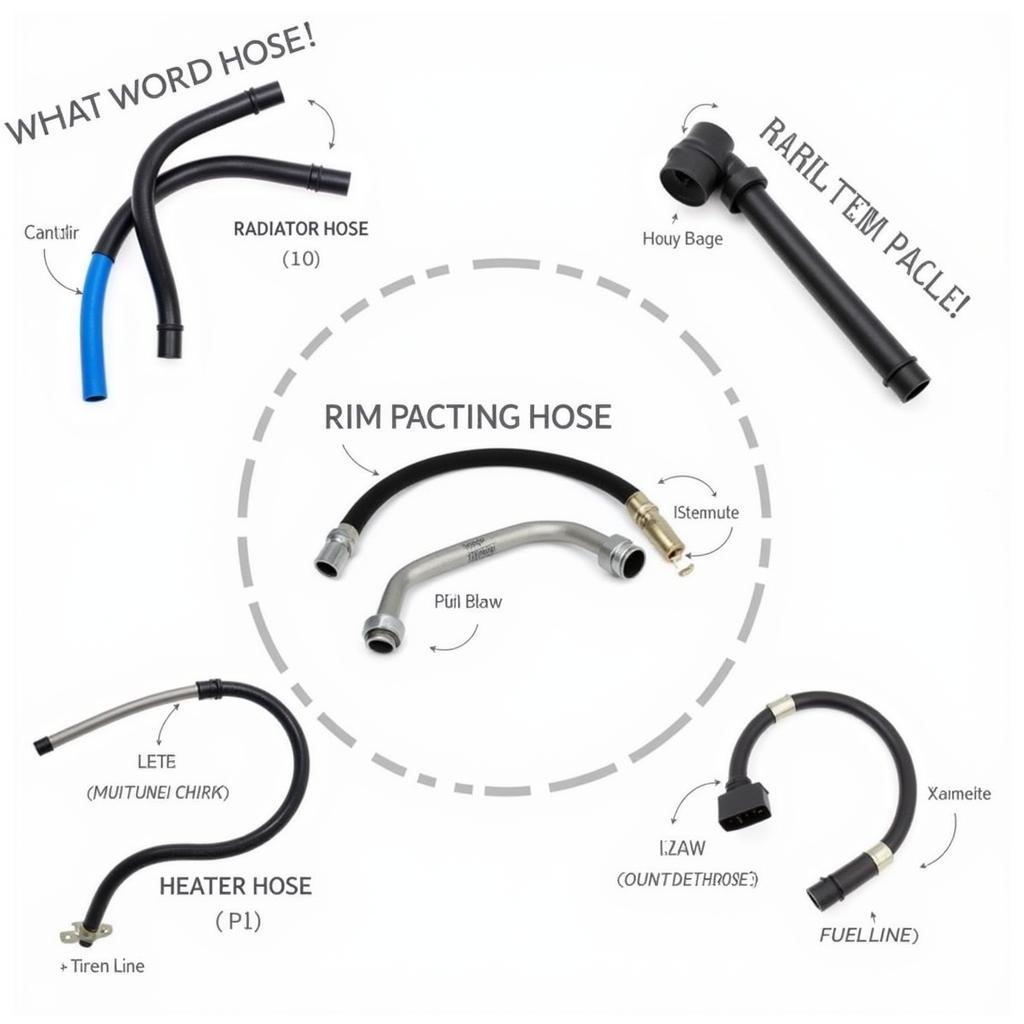A leaky or damaged car hose can lead to serious engine problems. Knowing how to fix a car hose is essential for any car owner or mechanic. This guide provides a step-by-step approach to diagnosing and repairing various car hose issues, from minor leaks to complete replacements.
Identifying the Damaged Hose
Before you begin the repair, it’s crucial to correctly identify the damaged hose. Different hoses serve different purposes, from carrying coolant to transmitting vacuum pressure. Look for signs of damage like cracks, bulges, or leaks. Inspect the area around the hose for signs of fluid residue. This can help pinpoint the source of the leak.
Gathering Your Tools and Materials
Having the right tools and materials will make the repair process smoother. You will typically need:
- New car hose of the correct type and size
- Hose clamps
- Screwdrivers
- Pliers
- Coolant or other appropriate fluids (if necessary)
- Safety glasses and gloves
- A container to catch any spilled fluids
Similar to fixed a car diagnostic, understanding the issue before tackling it is crucial.
 Identifying a Leaking Car Hose
Identifying a Leaking Car Hose
Draining and Disconnecting the Hose
Once you’ve located the damaged hose, you’ll need to drain any fluids it contains. If it’s a coolant hose, allow the engine to cool completely before opening the radiator cap. Place a container beneath the hose to collect the fluid. Then, loosen the hose clamps with a screwdriver or pliers and carefully disconnect the hose.
Installing the New Hose
Ensure the new hose is the correct type and size for your vehicle. Lubricate the ends of the new hose with a little coolant or water for easier installation. Slide the hose clamps onto the hose before attaching it to the corresponding fittings. Secure the clamps tightly, but avoid over-tightening, which can damage the hose.
Refilling Fluids and Testing
After installing the new hose, refill the system with the appropriate fluid, such as coolant. Start the engine and check for leaks. Look closely at the connections and along the length of the new hose. If you see any leaks, tighten the clamps or repeat the installation process.
Just as with a how to fix a car remote that got wet, addressing the root cause is key.
Common Car Hose Problems and Solutions
Several factors can cause car hose problems. Here are a few common issues:
- Cracked hoses: Replace the cracked hose immediately.
- Leaking hoses: Check the clamps first. If they’re loose, tighten them. If the hose itself is leaking, replace it.
- Bulging hoses: A bulge usually indicates a weak spot in the hose. Replace the hose as soon as possible to prevent a rupture.
- Collapsed hoses: This could be a sign of a blockage or vacuum leak. Inspect the hose and related components.
“Regular inspection of your car hoses is essential for preventative maintenance,” advises John Smith, Automotive Engineer at Smith Automotive Solutions. “Catching a problem early can save you from costly repairs down the road.”
 Various Types of Car Hoses
Various Types of Car Hoses
If you’re considering selling your older vehicle, knowing how to fix minor issues can increase its value. Check out our article on 20 year old car sell or fix for more information.
Conclusion
Knowing how to fix a car hose is a valuable skill for any car owner. By following these steps and taking preventative measures, you can keep your car running smoothly and avoid potentially serious engine problems. Regularly inspecting your hoses for signs of wear and tear is crucial. If you’re unsure about any step in the process, don’t hesitate to contact us at AutoTipPro for assistance. Our number is +1 (641) 206-8880 and our office is located at 500 N St Mary’s St, San Antonio, TX 78205, United States.
“A little preventative maintenance can go a long way in extending the life of your car’s hoses,” adds Jane Doe, Lead Mechanic at Doe’s Auto Repair. “It’s a simple check that can prevent major headaches.” Need reviews on car repair apps? See our article on fixed app for cars reviews. Perhaps you’ve seen a hot chick fixing car gif and been inspired to learn more.
FAQ
-
How often should I check my car hoses? It’s a good idea to inspect your hoses every month or so, and more frequently in extreme temperatures.
-
What kind of hose should I use for replacement? Always use a hose that meets or exceeds the manufacturer’s specifications for your vehicle.
-
Can I patch a leaking hose? While temporary patches are available, it’s always best to replace a leaking hose for a permanent solution.
-
What causes car hoses to burst? Hoses can burst due to age, wear and tear, extreme temperatures, or over-tightening of clamps.
-
How do I know if a hose is the right size? The old hose should have markings indicating its size. You can also consult your vehicle’s owner’s manual.
-
What happens if a car hose bursts while driving? Depending on the hose, this can lead to overheating, loss of power steering, or other serious problems. Pull over safely and call for assistance.
-
How much does it cost to replace a car hose? The cost varies depending on the type of hose and the labor involved, but it’s generally a relatively inexpensive repair.




Leave a Reply